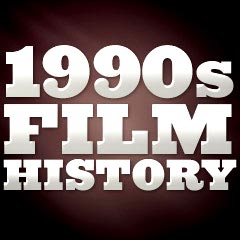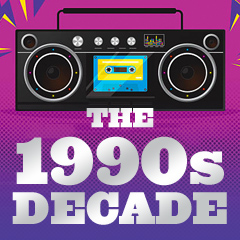|
Trends in the 90s: Films with Serious Themes
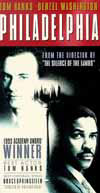 The
trend toward sequels from the previous decade continued, but Hollywood
was also attempting to deal with serious themes, including homelessness,
the Holocaust, AIDS, feminism, and racism, while making bottom-line profits.
There were a number of mainstream films that confronted the issues in
a profound way. Director Jonathan Demme's Philadelphia (1993) was
the first big-studio attempt to deal with AIDS, winning for Tom Hanks
the first of consecutive Best Actor Oscars. He starred as a lawyer with
AIDS who found that Denzel Washington was the only person who would take
his case. The
trend toward sequels from the previous decade continued, but Hollywood
was also attempting to deal with serious themes, including homelessness,
the Holocaust, AIDS, feminism, and racism, while making bottom-line profits.
There were a number of mainstream films that confronted the issues in
a profound way. Director Jonathan Demme's Philadelphia (1993) was
the first big-studio attempt to deal with AIDS, winning for Tom Hanks
the first of consecutive Best Actor Oscars. He starred as a lawyer with
AIDS who found that Denzel Washington was the only person who would take
his case.
With seven Oscars including Best Picture and Best Director,
Steven Spielberg's long and serious B/W Holocaust 'prestige' epic Schindler's
List (1993) was a significant milestone but also a grim story
about an opportunistic German businessman (Liam Neeson) in Poland who
ultimately saved over 1,000 Jews from a Holocaust death by employing them
as cheap labor. This historical drama was released only a few months after
Spielberg's major entertainment blockbuster Jurassic Park (1993).
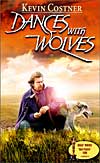 Soon
before its bankruptcy in 1991, Orion Pictures distributed the three-hour
western - director/producer/actor Kevin Costner's Dances with Wolves
(1990), that retold the story of the Wild West from the viewpoint
of Native Americans and displayed some of the subtitled dialogue in Sioux.
Kevin Costner starred as Lt. John Dunbar who married Stands With a Fist
(Mary McDonnell), and inadvertently became a hero. The film won the Best
Picture Academy Award and six other Oscars, the first "western" to do
so since Cimarron (1931). Soon
before its bankruptcy in 1991, Orion Pictures distributed the three-hour
western - director/producer/actor Kevin Costner's Dances with Wolves
(1990), that retold the story of the Wild West from the viewpoint
of Native Americans and displayed some of the subtitled dialogue in Sioux.
Kevin Costner starred as Lt. John Dunbar who married Stands With a Fist
(Mary McDonnell), and inadvertently became a hero. The film won the Best
Picture Academy Award and six other Oscars, the first "western" to do
so since Cimarron (1931).
Orion also released Jonathan Demme's The
Silence of the Lambs (1991), a chilling thriller about serial
killer Hannibal Lecter (Anthony Hopkins) and featuring Jodie Foster as
young agent Clarice Starling seeking help from the psychopath to catch
another psychopath named Buffalo Bill. The remarkable film swept the top
five Oscars (Picture, Director, Actor, Actress, and Writer) - it was the
first horror film to be so honored. [It repeated the earlier success
of two other sweep films: One Flew Over the Cuckoo's
Nest (1975) and It Happened One Night (1934).]
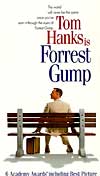 The
immensely popular box-office hit Forrest Gump (1994) by director
Robert Zemeckis looked back on the 60s and Vietnam War era through the
eyes of a slow-witted Everyman (Best Actor-winning Tom Hanks with his
second Oscar win), reportedly with an IQ of 75. He would spout Gump-isms
("Life is like a box of chocolates") and the film's exceptional special
effects placed the unassuming Forrest within documentary newsreels - creating
the illusion of meeting with Presidents (Kennedy, Johnson and Nixon),
missing legs and the finale's floating feather. The
immensely popular box-office hit Forrest Gump (1994) by director
Robert Zemeckis looked back on the 60s and Vietnam War era through the
eyes of a slow-witted Everyman (Best Actor-winning Tom Hanks with his
second Oscar win), reportedly with an IQ of 75. He would spout Gump-isms
("Life is like a box of chocolates") and the film's exceptional special
effects placed the unassuming Forrest within documentary newsreels - creating
the illusion of meeting with Presidents (Kennedy, Johnson and Nixon),
missing legs and the finale's floating feather.
Racial issues and social tensions were disturbingly portrayed
by Michael Douglas in Falling Down (1993). Actor Tim Robbins' independent
film Dead Man Walking (1995) confronted the issue of capital punishment
in a powerful tale with Oscar-winning Susan Sarandon portraying real-life
Catholic nun Sister Helen Prejean as a death-row spiritual counselor for
convicted murderer and rapist Sean Penn. In Scent
of a Woman (1992), Best Actor-winning Al Pacino starred as a blind
ex-Marine (Col. Frank Slade), known for saying "Hoo-hah!", who
intended to commit suicide - until hiring a young college student (Chris
O'Donnell).
African-American Film-Makers:
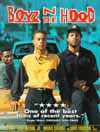 And
black filmmakers, including John Singleton, Spike Lee and Mario Van Peebles
(among others) were making an impact. Twenty-three year old writer/director
John Singleton marked his directorial debut with the semi-autobiographical
Boyz N The Hood (1991), a powerful film about gang violence in
South Central L.A. [Singleton's nominated film brought him the distinction
of being the first African-American and the youngest person ever nominated
for the Best Director Academy Award. At the time of its release, the film
was the highest-grossing, black-themed film ever, earning ten times its
$6 million budget.] However, the film's marketing incited some violence
and trouble when it opened in various theaters. And
black filmmakers, including John Singleton, Spike Lee and Mario Van Peebles
(among others) were making an impact. Twenty-three year old writer/director
John Singleton marked his directorial debut with the semi-autobiographical
Boyz N The Hood (1991), a powerful film about gang violence in
South Central L.A. [Singleton's nominated film brought him the distinction
of being the first African-American and the youngest person ever nominated
for the Best Director Academy Award. At the time of its release, the film
was the highest-grossing, black-themed film ever, earning ten times its
$6 million budget.] However, the film's marketing incited some violence
and trouble when it opened in various theaters.
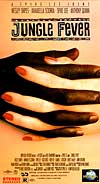 After
Mo' Better Blues (1990), writer/director Spike Lee's Jungle
Fever (1991) told a story of inter-racial romance between Annabella
Sciorra and Wesley Snipes. New Jack City (1991), with actor Wesley
Snipes was a realistic film about inner city drug violence. Lee's big-budget
biopic of the black political and religious activist Malcolm X (1992),
with Denzel Washington in the title role as the radical 1960s assassinated
leader, was an ambitious, stirring production, and caused controversy
among African-American groups. Another conflict arose when the high-school
basketball documentary about inner-city Chicago, Hoop Dreams (1994)
failed to receive an Oscar nomination (as Best Picture or Best Documentary),
although it won documentary awards from the Sundance Film Festival, the
New York Film Critics Circle, and the LA Film Critics Association. After
Mo' Better Blues (1990), writer/director Spike Lee's Jungle
Fever (1991) told a story of inter-racial romance between Annabella
Sciorra and Wesley Snipes. New Jack City (1991), with actor Wesley
Snipes was a realistic film about inner city drug violence. Lee's big-budget
biopic of the black political and religious activist Malcolm X (1992),
with Denzel Washington in the title role as the radical 1960s assassinated
leader, was an ambitious, stirring production, and caused controversy
among African-American groups. Another conflict arose when the high-school
basketball documentary about inner-city Chicago, Hoop Dreams (1994)
failed to receive an Oscar nomination (as Best Picture or Best Documentary),
although it won documentary awards from the Sundance Film Festival, the
New York Film Critics Circle, and the LA Film Critics Association.
Co-scripter-director Lee's Clockers (1995), co-produced
by Martin Scorsese, was a penetrating, sober examination of the vicious
cycle of drug-dealing on the streets in the modern urban world. The Hughes
brothers' Dead Presidents (1995) followed the coming-of-age odyssey
of a young black man (Larenz Tate) from his late 60s Bronx upbringing
through a Vietnam tour of duty and back to his life in the 'hood in 1973.
Allen and Albert Hughes directed the powerful and daring inner-city film
about a conflicted teenage gang member entitled Menace II Society (1993).
Female Film-Makers and a New Feminist Consciousness:
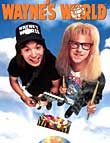 Similarly,
from the 80s into the 90s, female directors were exerting greater influence
and demonstrating their skill within the film industry: Barbra Streisand
with her first film Yentl (1983) (as director/producer/co-writer/actor)
and The Prince of Tides (1991), Penny Marshall with the soul-transference
fantasy/comedy Big (1988) starring Tom Hanks as a youngster in
an adult body, Penelope Spheeris with Wayne's World (1992) starring
Mike Myers and Dana Carvey from TV's Saturday Night Live, Kathryn
Bigelow with the exciting, fast-moving action-crime film Point Break
(1991) and the dark, virtual reality futuristic film Strange Days
(1995), and New Zealand director Jane Campion with the Oscar winning
sensual and haunting masterpiece that was filmed from a female perspective
The Piano (1993) - a love story set in 19th century New Zealand
about the tragic consequences of an arranged marriage and erotic passion
between mute Holly Hunter and native Harvey Keitel. Similarly,
from the 80s into the 90s, female directors were exerting greater influence
and demonstrating their skill within the film industry: Barbra Streisand
with her first film Yentl (1983) (as director/producer/co-writer/actor)
and The Prince of Tides (1991), Penny Marshall with the soul-transference
fantasy/comedy Big (1988) starring Tom Hanks as a youngster in
an adult body, Penelope Spheeris with Wayne's World (1992) starring
Mike Myers and Dana Carvey from TV's Saturday Night Live, Kathryn
Bigelow with the exciting, fast-moving action-crime film Point Break
(1991) and the dark, virtual reality futuristic film Strange Days
(1995), and New Zealand director Jane Campion with the Oscar winning
sensual and haunting masterpiece that was filmed from a female perspective
The Piano (1993) - a love story set in 19th century New Zealand
about the tragic consequences of an arranged marriage and erotic passion
between mute Holly Hunter and native Harvey Keitel.
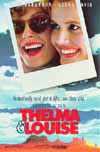 Ridley
Scott's radical wide-screen film Thelma and Louise (1991) with
a debut script by Callie Khouri (that won a Best Screenplay Oscar) has
been noted as the first feminist-buddy/road film with two raging female
heroines. Although controversial and defiant (like its counterpart Easy
Rider (1969) was in its day), it offered splendid character roles
to two actresses Susan Sarandon (as fed-up, overworked waitress Louise)
and Geena Davis (as housewife Thelma) portraying outlaw women in flight
across the American Southwest from abusiveness in marriage, rape and the
law. [Incidentally, the film also launched Brad Pitt as a new star.] Director
Penny Marshall's A League of Their Own (1992) was the true story
of WWII manpower shortages that impacted baseball. Tom Hanks managed an
all-female baseball team which included Geena Davis and Madonna. Ridley
Scott's radical wide-screen film Thelma and Louise (1991) with
a debut script by Callie Khouri (that won a Best Screenplay Oscar) has
been noted as the first feminist-buddy/road film with two raging female
heroines. Although controversial and defiant (like its counterpart Easy
Rider (1969) was in its day), it offered splendid character roles
to two actresses Susan Sarandon (as fed-up, overworked waitress Louise)
and Geena Davis (as housewife Thelma) portraying outlaw women in flight
across the American Southwest from abusiveness in marriage, rape and the
law. [Incidentally, the film also launched Brad Pitt as a new star.] Director
Penny Marshall's A League of Their Own (1992) was the true story
of WWII manpower shortages that impacted baseball. Tom Hanks managed an
all-female baseball team which included Geena Davis and Madonna.
Writer/director Nora Ephron, famous for When
Harry Met Sally...(1989) created the witty, simple romantic comedy
Sleepless in Seattle (1993) (a re-make of An Affair to Remember
(1957)) with Tom Hanks and Meg Ryan as the perfect couple brought
together by a talk-radio program. Ephron also directed the fantasy comedy
Michael (1996) with John Travolta as the atypical title character
- an angel (with wings) who drank, smoked, swore, and lived in Iowa. After
her success in The Silence of the Lambs (1990),
actress Jodie Foster became a producer and director for Egg Pictures,
releasing her directorial debut film Little Man Tate (1991) and
then a comedy about family relationships on Thanksgiving weekend titled
Home for the Holidays (1995).
Fried Green Tomatoes at the Whistle Stop Cafe (1991),
adapted from Fannie Flagg's popular women's novel, starred Jessica Tandy
as an elderly storyteller in a nursing home and Kathy Bates as an emotionally-repressed
housewife who found strength and independence through the recollections.
Another feminist film The Joy Luck Club (1993), an adaptation of
Amy Tan's novel with the theme of mother-daughter relationships, told
of four mothers from China (who met weekly to play Mah-Jongg) whose daughters
were born in America. The First Wives Club (1996) was about three
friends (Goldie Hawn, Bette Midler, and Diane Keaton) who decided to get
revenge on their unfaithful ex-husbands.
As a sign of the times, the Alien films (1979, 1986, 1992, and 1997) spotlighted a self-reliant female heroine - Lieut. Ellen Ripley (Sigourney Weaver). [The popular protagonist was killed off in the third installment, David Fincher's Alien3 (1992), but then brought back through cloning in the fourth film, Alien Resurrection (1997)].
Action-Thrillers Dominate the 90s:
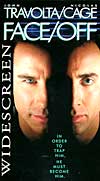 There
seemed to be a significant shift toward action films in the 90s - with
their requisite speed, kinetic hyper-action, and of course, violence.
Most of the biggest and popular films were not dialogue-based and character-driven.
One of the greatest summer smashes of the decade was Andrew Davis' The
Fugitive (1993) - a spin-off from the celebrated 1963-67 TV series
(with David Janssen), with Harrison Ford as the wrongly-convicted surgeon
Dr. Richard Kimble in flight from dogged US Marshal (Tommy Lee Jones)
and in pursuit of a one-armed man. Brian De Palma's big-budget slick summer
blockbuster Mission: Impossible (1996) derived from the popular
1960s TV series, was financially successful given its Tom Cruise star
power and huge marketing campaign. Sylvester Stallone was in the title
role of Demolition Man (1993) in pursuit of Wesley Snipes in futuristic
San Angeles. There
seemed to be a significant shift toward action films in the 90s - with
their requisite speed, kinetic hyper-action, and of course, violence.
Most of the biggest and popular films were not dialogue-based and character-driven.
One of the greatest summer smashes of the decade was Andrew Davis' The
Fugitive (1993) - a spin-off from the celebrated 1963-67 TV series
(with David Janssen), with Harrison Ford as the wrongly-convicted surgeon
Dr. Richard Kimble in flight from dogged US Marshal (Tommy Lee Jones)
and in pursuit of a one-armed man. Brian De Palma's big-budget slick summer
blockbuster Mission: Impossible (1996) derived from the popular
1960s TV series, was financially successful given its Tom Cruise star
power and huge marketing campaign. Sylvester Stallone was in the title
role of Demolition Man (1993) in pursuit of Wesley Snipes in futuristic
San Angeles.
During the 1993 filming of the martial arts action-thriller
adapted from a comic book, The Crow (1994), Bruce Lee's actor
son Brandon was killed in an accident on the set. Hong Kong action director
John Woo proved that he could make mainstream Hollywood films with the
high-powered Broken Arrow (1996), his second US film, and filled
with Woo's trademark action sequences. He also directed Face/Off (1997),
a brilliantly-acted film with stars John Travolta as an FBI agent and
Nicolas Cage as the villain - who both swapped faces after plastic surgery.
 Jan
de Bont's action disaster-thriller Speed (1994) was just as its
title suggested - a fast-paced, out-of-control tale about a mad bomber
(Dennis Hopper) vs. an LA SWAT team cop (Keanu Reeves), and a runaway
suburban LA bus (driven by Sandra Bullock) wired to explode if it slowed
below 50 mph. The vacation-cruise sequel Speed 2: Cruise Control (1997)
paled in comparison. The producers of Top Gun (1986) made their
last film The Rock (1996) - Michael Bay's successful action thriller
with an all-star cast set on the island prison Alcatraz, with renegade
Marines (led by Ed Harris) and a task force teaming Sean Connery and Nicolas
Cage. Jan
de Bont's action disaster-thriller Speed (1994) was just as its
title suggested - a fast-paced, out-of-control tale about a mad bomber
(Dennis Hopper) vs. an LA SWAT team cop (Keanu Reeves), and a runaway
suburban LA bus (driven by Sandra Bullock) wired to explode if it slowed
below 50 mph. The vacation-cruise sequel Speed 2: Cruise Control (1997)
paled in comparison. The producers of Top Gun (1986) made their
last film The Rock (1996) - Michael Bay's successful action thriller
with an all-star cast set on the island prison Alcatraz, with renegade
Marines (led by Ed Harris) and a task force teaming Sean Connery and Nicolas
Cage.
After their 1995 successes with Braveheart (1995)
and Apollo 13 (1995) - a true story about a near-space disaster
(with Tom Hanks as astronaut Jim Lovell), Ron Howard teamed with Mel Gibson
for the suspenseful crime-kidnapping thriller Ransom (1996), a
remake of the 1950s film Ransom (1956) starring Glenn Ford. Two
mid-air thrillers included:
- Stuart Baird's debut directorial film Executive Decision (1996) - an Islamic terrorist hijack story on a 747 jetliner
- Simon West's glossy mega-movie Con Air (1997),
with action star of the decade Nicolas Cage aboard a federal marshal's
plane with an assortment of vile criminals
 Film History of the 1990s
Film History of the 1990s
Part 1, Part 2, Part 3, Part 4, Part 5, Part 6

 
|
